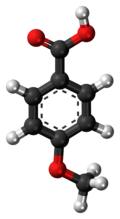p-Anisic acid
| |||
| Names | |||
|---|---|---|---|
| Preferred IUPAC name
4-Methoxybenzoic acid | |||
| Other names
Draconic acid
| |||
| Identifiers | |||
3D model (JSmol)
|
|||
| 508910 | |||
| ChEBI | |||
| ChEMBL |
| ||
| ChemSpider | |||
| ECHA InfoCard | 100.002.562 | ||
| EC Number |
| ||
| 3499 | |||
| KEGG | |||
PubChem CID
|
|||
| UNII | |||
CompTox Dashboard (EPA)
|
|||
| |||
| |||
| Properties | |||
| C8H8O3 | |||
| Molar mass | 152.149 g·mol−1 | ||
| Density | 1.385 g/cm3 | ||
| Melting point | 184 °C (363 °F; 457 K) (sublimation) | ||
| Boiling point | 275 to 280 °C (527 to 536 °F; 548 to 553 K) | ||
| 1 part per 2500 | |||
| Acidity (pKa) | 4.47[2] | ||
| Structure[3] | |||
| monoclinic | |||
| P21/a | |||
a = 16.98 Å, b = 10.95 Å, c = 3.98 Å α = 90°, β = 98.7°, γ = 90°
| |||
Formula units (Z)
|
4 | ||
| Hazards | |||
| GHS labelling:[4] | |||

| |||
| Warning | |||
| H302, H315, H319, H335 | |||
| P261, P264, P270, P271, P280, P301+P312, P302+P352, P304+P340, P305+P351+P338, P312, P330, P332+P313, P337+P313, P362, P403+P233, P405 | |||
Except where otherwise noted, data are given for materials in their standard state (at 25 °C [77 °F], 100 kPa).
| |||
p-Anisic acid, also known as 4-methoxybenzoic acid or draconic acid, is one of the isomers of anisic acid. The term "anisic acid" often refers to this form specifically.[1] It is a white crystalline solid which is insoluble in water, highly soluble in alcohols, and soluble in ether and ethyl acetate.[1]
Synthesis and occurrence
[edit]p-Anisic acid is found naturally in anise.[citation needed] It was first synthesized in 1841 by Auguste Cahours by oxidizing anethole that he had isolated from anise by recrystallization with diluted nitric acid:[5][6]
- CH3CH=CHC6H4OCH3 + HNO3 → CH3OC6H4CHO + others
- CH3OC6H4CHO + HNO3 → CH3OC6H4COOH + others
Oxidation of anisaldehyde, which was Cahours' intermediate product, is still used nowadays.[7] Anisic acid can also be obtained synthetically by the oxidation of p-methoxyacetophenone.
Uses
[edit]p-Anisic acid has antiseptic properties.[8] It is also used as an intermediate in the preparation of more complex organic compounds.
References
[edit]- ^ a b c Merck Index, 11th Edition, 696
- ^ Braude, E. A.; Nachod, F. C., eds. (1955). Determination of Organic Structure by Physical Methods. Academic Press. ISBN 9781483275727.
- ^ Bryan, Robert F. (1967). "An X-ray study of the p-n-alkoxybenzoic acids. Part II. The crystal structure of anisic acid". Journal of the Chemical Society B: Physical Organic: 1311–1316. doi:10.1039/j29670001311. ISSN 0045-6470.
- ^ "4-Methoxybenzoic acid". pubchem.ncbi.nlm.nih.gov. Retrieved 22 December 2021.
- ^ Wisniak, Jaime (2013-10-01). "Auguste André Thomas Cahours". Educación Química. 24 (4): 451–460. doi:10.1016/S0187-893X(13)72500-X. ISSN 0187-893X.
- ^ Crochard (París); Arago, François; Gay-Lussac, Joseph Louis (1841). Annales de chimie et de physique (in French). Chez Crochard.
- ^ Saha, Rumpa; Ghosh, Aniruddha; Saha, Bidyut (2013). "Kinetics of micellar catalysis on oxidation of p-anisaldehyde to p-anisic acid in aqueous medium at room temperature". Chemical Engineering Science. 99: 23–27. Bibcode:2013ChEnS..99...23S. doi:10.1016/j.ces.2013.05.043.
- ^ Herman, Anna (2019). "Antimicrobial Ingredients as Preservative Booster and Components of Self-Preserving Cosmetic Products". Current Microbiology. 76 (6): 744–754. doi:10.1007/s00284-018-1492-2. PMID 29651551.


